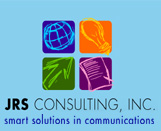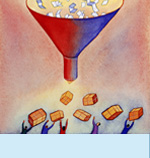


  |
||||
| PRINTER
FRIENDLY VERSION
Getting the Skinny: Whether or not you’ve been retained to specifically conduct interviews, it would be unusual to embark upon an initiative without speaking with key stakeholders to gather background or input. In fact, if you’re not doing this regularly, you’re probably not getting the whole story. These may be formal interviews, in which you are gathering data from customers or employees. Or, you may be chatting with team members to get their perspective or support for an initiative. In either case, it helps to have a strategic approach so that you use time most effectively, both for your sake as well as for your interviewee. Following are my suggestions for ensuring that interviews are productive: 1. Conduct enough interviews so that you can feel confident in your findings. Or, as a client from Kraft Foods once said, “At the end of the interviews, I want to know in my gut that what you are recommending is the right thing to do.” Here’s a quick example: An organization in the hospitality industry engaged JRS Consulting to determine what was behind a dramatic downturn in customer traffic. Our client was sure the physical amenities were to blame, and we were asked to interview customers about potential improvements to the facility. Our confidential customer interviews revealed that the real issue was a service problem, beginning with the general manager and cascading down through the staff. Expensive physical renovations weren’t required; the key to improvement was intensive customer service training. Because this startling revelation was the result of 30 interviews with key customers, our client “knew it in his gut” that we were on the right track. Five interviews wouldn’t have done it – or done justice to the staff. It was imperative that we speak to enough customers to ensure our findings were accurate. 2. Ask an influencer to pave the way for your interview request. For example, have company leadership send an email or letter briefly reviewing the initiative and that you will be in touch to schedule an interview. This will significantly increase the likelihood of your obtaining the interview. 3. Obtain background information on the respondent. Learn his or her title, time in position and any key accomplishments. This will help you to have perspective on responses as well as provide “warm-up” exchanges, i.e. “I understand you have just returned from two years in London…” 4. Arrange for privacy. You can conduct interviews by telephone or in person in an office or conference room. Cubicles don’t typically provide enough opportunity for private conversation. If you will interview a respondent by phone who normally works in a cubicle, ask that he take your call in a conference room so that he feels comfortable speaking candidly. When geographically feasible, it’s helpful to conduct at least a portion of the interviews live so that you can actually see the office environment and culture. 5. Assure respondents of confidentiality. I typically offer the following explanation to interviewees, “Our interview is confidential in the sense that I never quote anyone directly. You are one of a number of people being interviewed. At the end of our work, we summarize our findings in a report. Sometimes we might use a quote because it helps our clients understand our point, but we never attribute that quote to any individual in particular.” 6. Take notes – do not rely on your memory. I can assure you that after talking to 15 or 50 (especially 50!) people, you can easily become confused about aspects of the study, particularly if time has passed and you are looking back on your research for information. Notes provide a level of accuracy that is critical for a complete and credible analysis. 7. Set a definite time limit for the interview and respect it. With individual interviews, I never need more than 40 minutes and often get what I need in 20-30 minutes. Sticking to the agreed-up time is a sign of respect for your respondent. For example, when employees tell me that they feel stretched during a hiring freeze and don't have enough time to get their work done, what kind of message am I sending if I keep them an extra 15 minutes for an interview? It's much better to acknowledge the demands on their time and make a clear effort to end the discussion on time. 8. Develop about 10 questions that you will ask consistently during the interviews. This preparation will help organize your discussions and serve as a starting point. Once you have completed several interviews, you can vary from the questionnaire as you learn which areas seem straight-forward and which seem to require additional input. In addition, if you find that you’ve completed several interviews but haven’t had much time to cover a topic, begin the next few interviews with questions on that particular topic. 9. Never offer your own opinion or indicate a bias. You’re there to gather information, not make a sale. Deflect any questions back to the interviewee. If a respondent says, “What would you think if your boss expected you to work at home three days a week but wouldn’t pay for a fax machine?” Respond, “What does it say to you?” 10. Keep the interview focused. If a respondent digresses from the topic and espouses about other issues that aren’t relevant to the initiative, say something like, “Excuse me, but I know we only have 20 minutes and I don’t want to take up any more of your time. I was asking how you received the announcement about the restructuring yesterday.” 11. When you summarize your findings, be very careful to protect the anonymity of respondents. It’s fine to say, “One manager said…” But not, “A financial manager who recently returned from an expat assignment in Australia said….” 12. At the end of each interview, thank respondents for their time and insightful comments and ask if you may contact them with additional questions. I have never had to do that, but it’s a nice safety net if the need should arise. Also, if appropriate for your particular initiative and if the interview has gone well, you could ask if you could approach them at a later date for further input. If a mid-point pulse check seems desirable, you can return to the cadre of respondents you develop and know you will receive productive and immediate input. Employee or customer interviews are often a part of any communications or consulting initiative. Approaching these interviews with an organized methodology can make them significantly more productive and a better experience for both you and your respondents. NEXT ARTICLE
|
 |
|||
© 2008 JRS Consulting, Inc.